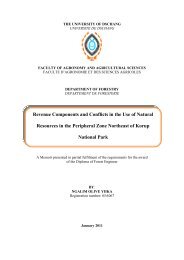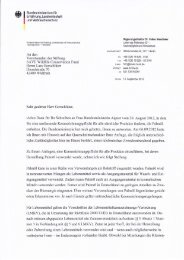African Lion - SAVE Wildlife Conservation Fund
African Lion - SAVE Wildlife Conservation Fund
African Lion - SAVE Wildlife Conservation Fund
- No tags were found...
Create successful ePaper yourself
Turn your PDF publications into a flip-book with our unique Google optimized e-Paper software.
© <strong>SAVE</strong>Lars Gorschlüter<strong>SAVE</strong> <strong>African</strong> Animals<strong>African</strong> <strong>Lion</strong><strong>Conservation</strong> and Classification
<strong>African</strong> PredatorsCarnivores belong to the family of mammals. The term “carnivora” was derived from the Latincaro, carnis (meat) and vorare (V). However, not all carnivores live off of meat. Ecologists describea predator as being an organism that consumes the whole or parts of other living organisms.Hence, their prey is still alive at the time of consumption. That is why herbivores, carnivores andparasites all belong to the same family of predators.© <strong>SAVE</strong>Carnivores have a highly important ecological function, as, by hunting prey, they prevent certainkinds from multiplying too much, which could otherwise harm certain vegetations and endanger thestabilization of the ecosystem. Predators are also referred to as ecological key stone species orumbrella species because of their particular preference in food, but also because of their size andtheir low psycho-logical tolerance regarding environmental fluctuations.Hence, their important ecological role makes predators quite valuable and worthy of protection. Ifthey are protected so are multitudes of other species. With that said, predators are one of varioussensitive indicators that account for the health of an eco system’s welfare.An important reason for the decline of many natural inhibited wildlife populations (especiallycarnivores) is the conflict between wild animals and humans. Even in our project’s region ofcentral Kalahari, such a conflict is present. The need for more land among the population hassteadily increased, which, in turn, has brought a growing pressure on wild animal habitats.
<strong>Conservation</strong> of <strong>African</strong> <strong>Lion</strong>s (Panthera leo)Throughout the <strong>African</strong> continent large predators such as the lion areunder serious threat due to fragmented landscapes, low densities and theinevitable conflict with people for space and resources.Protected areas such as national parks or privately owned conservanciestherefore remain critical for their conservation. However, there isincreasing evidence that even within protected areas where carnivoresshould thrive, the type of anthropogenic influence determines thesurvival of the species.IUCN (International Union for <strong>Conservation</strong> of Nature)Classification: Grade of endangerment: 3 – slightly endangered© <strong>SAVE</strong>
<strong>Lion</strong>sCharacteristics<strong>Lion</strong>s are the king of the jungle. They have a massive build and abundant strength. They can weigh up to 250 kilo; reach abody length of more than three meters and a shoulder height of up to one meter; and are said to be ten times strongerthan any human being. It only takes one stroke of the paw for a lion to break the necks of their prey.Hence, it is no surprise that the lion is found on so many crests, seals and flags, as it stands for power and dignity.Findings show that the first lion species lived over 1.75 million years ago.A typical characteristic is the illustrious lion mane. It takes up to five years for it to grow to its fullest splendor. The maneserves as protection to the male in battles with other animals. For this reason, the female lioness does not have a mane.Moreover, it would be more of a handicap, as the females are entrusted with hunting and breeding. To a further extent,studies show that male lions living in colder regions tend to have a fuller mane than those that are found in warmerclimates. Thus, they serve as a protection against the cold.A lion’s age can be calculated by the gradual discoloration of their teeth, called Melanism. They can live up to 20 years.Another famous feature is the tassel at the tip of a lion’s tail. The tassel conceals a rudimentary spine.© <strong>SAVE</strong> © <strong>SAVE</strong>HabitatToday, lions are found mostly south of the Sahara in the vastPlains Of West and East Africa.They have been extinct in North Africa since the 1940’s, becameHighly endangered this past century in Asia and only a fewhundred reside presently at Gir-Nationalpark in India.
© <strong>SAVE</strong>Social Behavior<strong>Lion</strong>s are group animals. They are social wild cats and said to be one of the most intelligent animals. They are not as cleanas house cats, as they only tend to clean the bridge of their nose regularly. However, cross-cleaning does occur in extremecases.<strong>Lion</strong>s live and hunt in prides of up to 30 other cats. The work distribution is well-defined among the animals. Prides can livein territories that range to 400 squared kilometers. They mark their territory by spraying their urine. Males are busydefending their territory while females care for the cubs and prey. Usually, a pride consists of about three males andrelated females with their cubs. The males are the head of the hierarchy. The hierarchy is sustained even when it comes toconsuming prey: first, the males eat, then the females and last, the cubs. Typically, if the young cubs are of the pride male,they precede the females. A male lion can devour up to 20 kilos of meat per meal. A lion’s roar serves as a defensemechanism and can be heard up to 8 kilometers away.<strong>Lion</strong>s hardly have any natural enemies because of their known strength. Only hyenas must be defeated occasionallybecause of the food rivalry between these two species, which has existed since primeval times. Saber tooth cats, forexample, an extinct wildcat line, often left at least half of their game for hyenas, mostly because back then, they hadundeveloped teeth that did not allow a full consumption. Hence, only the lion breed with the shorter teeth survived, which,in turn, resulted in the extinction of the referred to type of hyena. Thus, through evolution, a new type of hyena evolvedthat had to fight the lions for food from then on. Usually the lions win the fights and kill the hyenas. However, they nevereat them. Battles among a pride occur for the sake of the hierarchy. It is rare that they result in death. Yet, if a male„outsider“ tries to take over the pride a violent power struggle does arise. In the event that the intruder wins the fight, allthe pride’s cubs are killed. This way, the female lions are willing to mate quicker so the new pride leader can spread hisgenes. This insemination process can take up to four months.If the inferior loser happens to survive the battle it becomes a nomad and must forever fend for itself. Though usually itdies due to the effects of the brawl. Male lions tend to lead a pride for an average of 2-3 years, before a younger, strongersingle male banishes or kills them. Some are even able to reign over two prides at the same time. On the contrary, femalesusually stay associated with the same pack their whole lives. Young males must leave their pride when they have reachedtheir third year of birth. These single lions, known as nomadic males, graze through the plains until they are sexuallymature, which is around the age of five. Frequently, two or more nomadic males will form their own association and takeon new territories and their females. This is crucial to the lion species, as this way, they are able to intermix their genes.There is a 90% chance that a pride takeover is successful when there are three nomadic lions involved. The quota for onenomad to succeed is only 1:6. Naturally, single males favor weaker coalition partners, as to increase the chances ofspreading their own genes.
Diet<strong>Lion</strong>s hunt in groups. They prefer hunting in the morning or at night. They wait in ambush, encircle the prey, and then takeit down by using their claws to attack. The act of striking usually results in a tear of the prey’s aorta. Hence, it bleeds todeath. Most often, lions attack antelopes, gnus, buffalo and zebras, but in the national parks of Botswana they even huntyoung elephants and hippopotami.First, the mouth is eaten, intestines and organs follow. <strong>Lion</strong>s also enjoy eating the entrails of ruminants, as they are highlyrich in vitamins. Whoever is initially at the kill and begins eating first claims primacy. However, lions do eat collectively.Unlike leopards they will eat carrion. In fact, they account for 1/7th of a lion’s diet. An adult wildcat will typically eat up to20 animals a year.© <strong>SAVE</strong>ReproductionFemale lions become sexually mature between the age of three or four years. Males can smell the hormone odor femalesspread when they are in estrus. That is how they know it is mating season. For this purpose, males have a specific organcalled the "Jacobson-Organ", which is found in the lion’s palate. The male cat pulls its upper-lip back and opens its mouthin oder to perceive the lioness’ hormone level. However, it can not mate with a female if she is not willing to. Willingnessis projected when a lioness lays down on her stomach, thereby allowing the male to mount her. Females are generally inheat for five days. During this time copulations take place up to 40 times a day. The actual ovulation does not occur untilafter mating. If the male happens to be reproductively weak the female will seek a different mating partner.Breeding cycles can depend on the amount of prey. Often females of a pride breed synchronously. This serves to raise thecubs’ chance of survival, as there are no older cubs that eat the younger ones food. <strong>Lion</strong> offspring are blind the first twoweeks after birth. They are nursed for 6 months and aren’t weaned from their mother until after a year. They weigh abouttwo kilos when they are born. As a result of food shortage, negligence and the takeover of power by other males, only20% of lion cubs live to experience more than 2 years of life. 27% of all cubs die from the hierarchy invasion of anothermale lion. In order to increase the survival rate of a cub and to protect them from hunters, the females relocate todifferent hiding places every three to four days. During this process, they hold their cubs so they can not be traced. <strong>Lion</strong>cubs are not just nursed by their mothers, they are raised collectively. After about six months the young lions begin to eatmeat.When they are four months old they join their mother for the first time on a hunt and watch and learn. They do not fullymaster their hunting skills until they are two years old. They can not roar until then either.
EnemiesAccording to the IUCN (International Union for <strong>Conservation</strong> of Nature) there has been a 50 % decline of the lionpopulation in the past 30 years. Some experts even speak of a 90% reduction. Fact is, whereas in 1980, there were anestimated 250,000 lions, today they only number 20-30,000. The IUCN has red-listed them by giving them the rank of a"threatened species" (rank three). The cause for their level of endangerment is man, as lion hunting has always been afavorite past time to humans.Reasons for a lion’s threatened species status1. Trophy HuntingRoughly, since the beginning of man time, humans have been huntingfor lions. Today's vast hunting industry is proof enough. It is norm forhunters to hunt male lions. Overall, a total of 4-5000 lions are bred soman can hunt. Often, hunting farms offer lion killings for 16,000 dollars.Apart from the decline in lion population, the hunt for male lions alsoresults in a constant change of pride leader. When the head of a pridedies, a nomad usually takes over and kills the cubs. Such a chain ofeffects occurs in such short intervals that consequently, the death rateof cubs increases to 70%. Female lions may kill offspring that is notfrom a pride leader as well. Thus, a young lion’s chance of survivalincreases when a nomad coalition seizes a pride.2. Confrontation with farmersTime and again, farmers kill lions out of protection for their herds.Naturally, such farm herds are easy prey to lions that have wanderedout of the parks or their territory to find food. In addition, lions areeasily lured away beyond their borders when their prey is in search ofwater. However, there are many projects and ways that can preventlions from killing farmer’s herds. But unfortunately, farmers usuallychoose the easy way out and simply shoot the predators.Although they do get compensated by the government for their loss,there are regulations that are difficult to fulfill. The farmers must beable to prove that animals are missing and were killed by wild cats.Other ways of prevention are driving the herds into stables at night (lions are night active), 24 hour supervision by dogs(studies have shown that lions tend to avoid watch dogs), or erecting pens to keep the lions out and the herds in.Furthermore, wildlife parks could move nomad lions to more remote parks, as the nomads seem to be the ones thatkeep wandering back to the same farmyards. Additional solutions to avoid lion-wandering are to build water reservoirsand provide enough prey in the wildlife parks.Fact is, we must find a way to ensure the survival of this species, despite man. And the first most important measures totake are to raise awareness and approach the matter professionally.
3. Diseases such as LLF and the FIV Virus (Feline Immunodeficiency Virus)A dramatic problem among the wild cat populations since 1995 are the diseases LLF and FIV. Especially in thesouthern part of Kruger National Park in South Africa, tuberculosis and the FIV virus have taken their toll on lions. Tothis date, there is no vaccine for these diseases.Tuberculosis, which affects the digestive tract, is transmitted to lions through the eating of buffalo, which are viruscarriers through domestic cattle. <strong>Lion</strong>s with tuberculosis lose so much weight in such a short period of time thatamong other things, they are prone to more illnesses such as the FI Virus. Hence, mortality rates go up. Almost 90 %of the lions living in Kruger National Park have this bacterial infection. In 1962, it was an epidemic of biting house fliesthat killed many wild cats. As a result, a genetic shift took place, reducing the genetic diversity drastically.Most likely, the bacteria and viruses are originally brought to Africa by domestic dogs. 1000 lions died in the Serengetiin 1994 because of dogs that carried them. However, since house dogs can not survive in wildlife parks, there must bean animal that acts as an agent. Many study cases were performed and discoveries were made that 96% of all lionshave an anti-body for the Feline-Herpes-Virus. 42% have an immune complex for the Feline-Immune- Deficiency-Virusand 26% have one for the Canine-Distemper-Virus. Furthermore, experts found that the viruses in Botswana andTanzania form their own sub type. In Tanzania, it is said that the animals were infected by the Fi-virus much earlierthan it broke out. Similar to the Human Immunodeficiency Virus, it can take up to four years for an outbreak to occur.In cases as such, it is most likely that jackals are the agent. A way to determine the rate of infestation faster and moreefficiently would be affordable urine tests.A simple vaccination for house-held dogs alone would protect from such infectious diseases. Unfortunately, althoughseveral of these vaccinations are on the market, they are usually not enforced. Beyond that, a better control and aregistration of dogs would also be a productive attempt. A different approach would be to genetically mix the lionsfrom Kenya and South Africa.Obviously, there is still much to be done when it comes to calling attention to the problem, educating and actuallyimplementing solutions.© <strong>SAVE</strong>
© <strong>SAVE</strong>250.000200.000150.000100.00050.000-1975 1990 2002 2006© <strong>SAVE</strong>Figure 1: Shows the estimated population and the decline over the last 30-35 years.Picture: <strong>Lion</strong> darting , Kalahari, Botswana.In Africa, lions (Panthera leo) are on a rapid decline. From an estimated number of 200,000 <strong>African</strong>lions in 1975 (Myers, 1975), less than 100,000 remained by the early 1990s (Nowell & Jackson, 1996)and current population estimates range from as low as 23,000 (Bauer & van der Merwe, 2004) to39,000 (Chardonnet, 2002). The most recent, and probably most accurate, estimate numbers thecontinent-wide lion population at less than 28,000 (IUCN/SSC Cat Specialist Group, 2006).Key publications:Bauer, H., van der Merwe, S. (2004) Inventory of free-ranging lions (Panthera leo) in Africa. Oryx, 38:26-31Chardonnet, P. (2002) <strong>Conservation</strong> of the <strong>African</strong> lion. International Foundation for the <strong>Conservation</strong> of <strong>Wildlife</strong> and <strong>Conservation</strong> Force, ParisIUCN SSC Cat Specialist Group (2006). Regional <strong>Conservation</strong> Strategy for the lion Panthera leo in Eastern and Southern Africa. IUCN SSC Cat SpecialistGroup, Gland, SwitzerlandMyers, N. (1975) The silent savannas. International <strong>Wildlife</strong>, 5:5-10Nowell, K., Jackson, P. (eds) (1996) Wild cats: status survey and conservation action plan. IUCN, Gland
© <strong>SAVE</strong>









